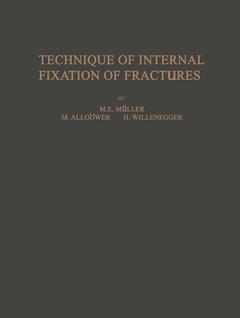Technique of Internal Fixation of Fractures, Softcover reprint of the original 1st ed. 1965
Langue : Anglais
Auteurs : Müller M. E., Bandi W., Bloch H. R., Allgöwer M., Willenegger H., Mumenthaler A., Schneider R., Steinemann S., Straumann F., Weber B. G.

It is to the great and lasting credit of LORENZ BOHLER and his school that they have in the last decade developed and demonstrated so thoroughly the techniques for the conservative management of fractures. Nevertheless there have always been many, including some from BOHLER'S school, who have found considerable place for surgical management, and with the significant progress in general surgery seen in postwar years, a new stimulus has been given to this part of traumatic surgery, especially since bone injuries have become more complex and frequent. The concept of internal fixation is not new. The serious criticisms that have been levelled at it retain today their basic significance. Progress in the fields of asepsis, corrosion-free metal implants, operative experience and postoperative care has diminished the dangers but has not relieved the surgeon of responsibility. The Association for the Study of the Problems of Internal Fixation (AO) has devoted itself over a number of years to the basic principles and best methods of open treatment of fractures by means of extended clinical and scientific studies in order to determine in each individual case the most promising line of treatment. At the same time a well designed and tested instrument set has been developed with precise instructions for the appropriate techniques. As a result, the new observations about primary bone healing which have emerged from the practice of rigid internal fixation are as interesting as the uses to which they can be put in allowing early mobilization.
General Technique.- A. Introduction.- I. Historical Review.- II. Objectives and Hazards of Internal Fixation.- III. Theoretical and Practical Principles of Rigid Internal Fixation.- a) Anatomical Reduction.- b) Rigid Fixation of the Fragments.- c) Vascularization of the Bone Fragments.- B. Operative Technique and Postoperative Management.- I. Basic Principles of Operative Technique.- II. Principles of Postoperative Care.- III. Follow-up Examinations.- IV. Timing of the Operation.- V. Removal of the Metal Used for Internal Fixation.- C. Instruments and their Use.- I. Metallurgical Considerations.- 1. Corrosion Resistance of Metals.- 2. Corrosion in Living Tissues.- 3. Local Effects of Corrosion on the Tissues (Metallosis).- 4. Metals Used in Practice.- 5. The Manufacture of the AOI Implants and Instruments.- II. Instruments.- 1. General Considerations.- 2. Cerclage Wiring, Pinning with Kirschner Wires and Traction Absorbing Wiring.- 3. Screw Fixation.- a) Technique of Screw Fixation.- b) Indications for Screw Fixation.- 4. Compression Fixation with Plates.- 5. Medullary Nailing.- a) Indications for Medullary Nailing.- b) Technique of Medullary Nailing of the Tibia.- 6. Angulated Blade Plates.- 7. Compression Fixation with External Compressors.- 8. General Instruments.- a) The AOI Set of Instruments.- b) Cortical Bone Set.- c) Cancellous Bone Set.- d) Compression Plate Set.- e) General Hip Instrument Set and Angulated Plates for Fractures.- f) Intramedullary Reaming Instrument Set.- g) Medullary Nails.- h) Impaction-Extraction Set for Medullary Nails.- i) External Compression Instruments.- k) General Instruments.- Special Fractures.- I. Fractures of the Tibia.- 1. Introduction.- 2. Operative Procedures.- a) Fractures of the Shaft.- b) Fractures of the Lower Quarter of the Tibia.- c) Fractures of the Proximal Quarter of the Tibia.- 3. Indications for Internal Fixation in Adolescents.- 4. Soft Tissue Considerations in Timing Operations for Tibial Fractures.- 5. Technical Details in the Care of the Soft Tissues.- 6. Postoperative Treatment of Lower Leg Fractures.- 7. Removal of Metal Implants Following Internal Fixation in the Leg.- 8. Complications of Medullary Nailing with Special Reference to the Tibia. R. Schneider.- II. Malleolar Fractures.- 1. Functional Anatomy.- 2. Pathological and Physiological Considerations.- 3. Clinical Aspects.- 4. Pros and Cons of Operative Treatment.- 5. Classification of Malleolar Fractures.- 6. Operative Technique.- a) General Technique.- b) Special Operative Technique.- ?) Management of the Fibula.- ?) Surgical Treatment of the Inferior Tibiofibular Joint.- ?) Management of the Medial Malleolus.- c) Postoperative Treatment.- III. Fractures of the Femur.- 1. Introduction.- 2. Positioning.- 3. Approach.- 4. Fractures of the Middle Third of the Shaft.- 5. Fractures of the Lower Third and of the Femoral Condyles.- IV. Fractures of the Patella.- V. Fractures of the Forearm.- 1. Fractures of the Shaft of the Radius and Ulna.- 2. Fractures of the Proximal End of the Ulna and of the Lower End of the Radius.- a) Fractures of the Olecranon.- b) Monteggia Fractures.- c) Fractures of the Lower End of the Radius.- VI. The Fractured Scaphoid.- 1. Physiology and Pathology.- 2. Indications for Surgery.- 3. Screwing of the Scaphoid.- VII. Fractures of the Humerus.- 1. Soft Tissues and Surgical Access to the Bone.- 2. Technique of Internal Fixation.- 3. Supracondylar Fractures of the Humerus.- VIII. Fractures in the Region of the Hip.- 1. Fractures of the Pelvis.- 2. Subcapital Fractures of the Femoral Neck.- 3. Pertrochanteric Fractures.- Supplement.- I. Internal Fixation of Compound Fractures.- II. Principles of Antibiotic Therapy and the Treatment of Infection Following Internal Fixation.- 1. Surgical Principles when Infection Follows Internal Fixation.- 2. Treatment of Infection with Antibiotics.- a) General.- b) Principles in the Use of Antibiotics.- c) Local Application of Antibiotics (Irrigation Drainage).- III. The Problem of Shock in Accident Surgery.- 1. Diagnosis of Shock.- 2. Pathogenesis of Posttraumatic Circulatory Disturbances.- 3. Treatment of Shock.- 4. Indications for Surgery in Patients with Shock.- Literature.
Date de parution : 04-2012
Ouvrage de 272 p.
21x27.9 cm
Disponible chez l'éditeur (délai d'approvisionnement : 15 jours).
Prix indicatif 52,74 €
Ajouter au panierThèmes de Technique of Internal Fixation of Fractures :
Mots-clés :
Bruch; Innere Medizin; Instrument; bone; fixation; fracture; implant; surgery; Trauma Surgery
© 2024 LAVOISIER S.A.S.



